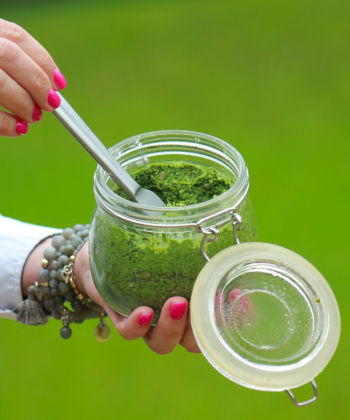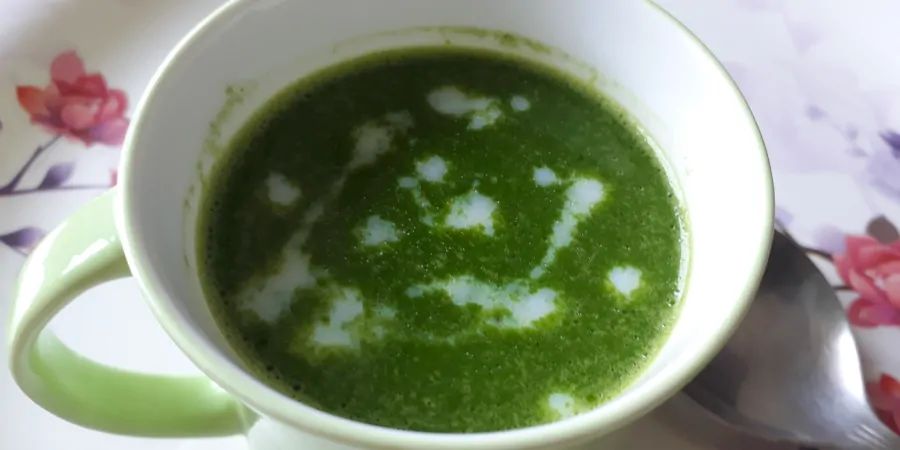Don´t Give Spinach To Children Under The Age Of One

It´s not safe to give spinach to your child under the age of one.
Spinach contains nitrate which can´t be broken down in a small child's body.
You need to be aware of this and not listen to others who might give you tips on how you should trick and/or learn your child to eat spinach.
We've read too many articles and seen too many posts on social media about tips and tricks to get your young child to love spinach in one form or the other.
So even though we love spinach and the benefits it can provide we recommend against giving children under the age of one any foods that contain a lot of nitrate.
In our book it's better to be safe than sorry.
Table of Contents
When Can I Introduce Spinach To My Child?
The Swedish National Food Agency's advice on food for children up to one year is based on collected research and is intended to be a support for parents.
From the Swedish national food agency's report "Good food for infants – under one year"
Wait to serve leafy green vegetables like lettuce, rocket, and spinach until your child is a year old. Then increase the amount bit by bit. These vegetables contain nitrates, which can be converted into nitrites in the body. In children under one year, nitrites can block the transport of oxygen in the blood.
(source ◳)
Why Is Spinach Bad For Babies?
It´s the high nitrate content in the spinach that's dangerous. Small children are particularly sensitive to nitrate because they are more easily affected by methemoglobinemia.
Methemoglobinemia occurs when the nitrates block the transport of oxygen in the blood.
The first symptoms of methemoglobinemia in young children are blue-colored fingers and nipples. You might have heard someone refer to a baby as a “blue baby”. This is why.
When the methemoglobinemia sets in the effects of it grow quickly as your child's tissues are seriously starved of oxygen.
The child becomes very pale and gets a blue skin color, which is called cyanosis.
If it continues it can lead to respiratory distress, seizures, coma, cardiac arrest, and even death!
Contact your emergency health service immediately if you suspect your child might have cyanosis or methemoglobinemia.

Other High Nitrate Foods To Avoid
The Swedish authorities give the same advice as spinach to foods such as kale, arugula, mangold, and celery.
Beetroot juice also contains a lot of nitrates and therefore you should avoid giving it to children under one year.
Why Does Spinach Affect Children Under The Age Of One?
Red blood cells contain enzymes which convert methemoglobin back to hemoglobin.
Young babies have a limited supply of these enzymes, and the protective mechanism is quickly overrun if too much nitrates are ingested.
The age at which the body starts making more of these enzymes is at the earliest 6 months of age.
This leads to that methemoglobinemia mostly affects infants under 6 months of age.
But you still need to be careful with what you give your child to eat. Just because the enzyme starts to develop doesn't mean that the child has adequate supply of enzymes to provide the needed protection.
The younger the child, the higher the risks.
Some children have disorders which result in a lifetime of diminished enzyme protection.
Diseases such as pyruvate kinase deficiency and G6PD deficiency increase the risk of methemoglobinemia well beyond the age of one.
What Is Nitrate?
Nitrate is a form of nitrogen (N) that is vital to the healthy growth and development of plants.
It's found naturally in soil but can be applied with a commercial fertilizer if the soil does not contain sufficient quantities.
Private unmonitored wells can have high nitrate concentrations
You can find nitrites in all kinds of elements. The most at-risk populations are those with private water sources.
Private wells that are not monitored can unknowingly have higher levels of nitrates, being hazardous to infants.
Breastfeeding protects your child from nitrates
However, there is evidence that breastfeeding is protective in exposed populations.
According to a clinical report from the American Academy of Pediatrics breastfeeding infants are not at risk of methemoglobinemia even when mothers ingest water with very high concentrations of nitrate-nitrogen because the nitrate concentration does not increase significantly in the milk. (source ◳)
Nitrate concentration depends on a variety of factors
Nitrate contents of plants and derived foods depend on the applied fertilization regimens, harvest time, and exposure to sunlight due to the photoperiodic accumulation of nitrate.
Some plants accumulate particularly high levels of nitrate in specific plant parts, namely in vascular bundles and green tissues.
Leafy and root vegetables such as lettuce, chard, spinach, radish, beetroot, celery, and particularly rocket, often contain exceptionally high concentrations of nitrate. (source ◳)
Organic vegetables contain less nitrates
It has shown that organic vegetables have lower nitrate levels than conventional vegetables. But this doesn't mean that they are safe to give to your child.
But it might be a good idea to give your child organic vegetables such as spinach when you decide to introduce it to your child.
Are Nitrates Dangerous?
Nitrates that occur naturally are okay to eat for everyone that are the age of one (if there aren't other medical reasons). There is no recommendation to limit vegetables that naturally contain nitrates.
But there are nitrates that have been added to foods to make their appearance and flavor more appealing. Also to preserve the products and prevent bacteria from growing.
For instance, nitrates give processed meats their pink color.
Food Preparation Affects Nitrate Levels
Nitrate levels can be affected by how the food is prepared. Vegetables must be frozen immediately after harvesting.
Then you shouldn't forget about your vegetables in your freezer, because you should not use vegetables that have been frozen for more than five months.
Vegetables should not be thawed for more than 15 hours at room temperature. Find a quicker way to thaw your vegetables before using them.
Do not store cooked foods of these vegetables for a long time.
You should eat your cooked spinach all at once. Avoid reheating spinach.
Finally, do not use water from your own well when preparing food for your child unless the nitrate content has been checked.
Conclusion: Avoid Foods With High Nitrate Content Until Your Child Is Old Enough
Every parent want what is best for their children. When it comes to what food to give your child food, it´s not always that easy to know what to do.
Spinach is a tricky vegetable, it´s actually one of the healthiest vegetables when it comes to its nutritional value.
But when it comes to the nitrate levels, the spinach has very high levels. That is why you should avoid serving spinach to your child under the age of one.
Even though your child starts to develop the enzyme that can break down nitrates at the age of six months, I recommend you to take the safe road and still wait before you serve your child spinach.
The same advice goes to giving foods such as kale, arugula, mangold, and celery. Beetroot juice also contains a lot of nitrates and therefore you should not give it to children under one year.
Remember!
Don't ignore symptoms such as pale/blue discoloration of the skin, rapid breathing or trouble breathing.
Methemoglobinemia can be treated, but only if you recognize the problem and seek medical attention immediately.
Please share this article with your friends and relatives. This practice of giving spinach to childen under the age of one has to be stopped. With your help we can!
Can eating spinach be unhealthy or even dangerous for children?
Yes, you should be careful with spinach with children under the age of one. Spinach contains nitrate which can´t be broken down in a small child's body. The body hasn’t developed the enzyme that is required to break down the nitrate.
When can I give my child spinach?
You should wait to serve leafy green vegetables like lettuce, rocket, and spinach until your child is a year old. First introduce it in small portions and increase the amount over time.
Are there any other foods, like spinach, that you should be careful with?
Yes, the same advice applies to foods such as kale, arugula, mangold, and celery. Beetroot juice also contains a lot of nitrates and therefore you should not give it to children under one year.
What is Blue Baby Syndrome?
Blue baby syndrome is the termn used when a baby's been affected by methemoglobinemia. Methemoglobinemia occurs when nitrates block the transport of oxygen in the blood. When the methemoglobinemia sets in the effects of it grow quickly as your child's tissues are starved of oxygen. The child becomes pale and gets a blue skin color. Contact your health-provider if you suspect your child might have it.


